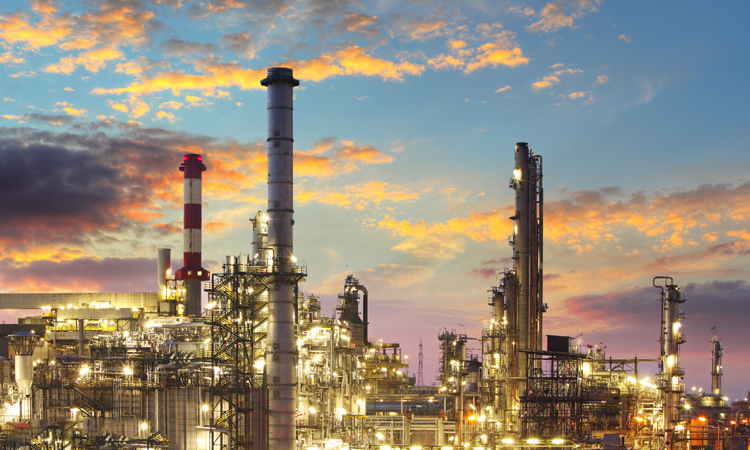Introduction
BioPetroClean has successfully completed a retrofit upgrade project for refinery waste water treatment. One of India’s largest oil refining companies was searching for a process that would improve effluent treatment at their Indian Oil Refinery (IOR). They required a solution that would treat water to the governmental standards for reuse or discharge in an easy and cost effective manner. The two main issues were that the IOR effluent water was out of spec with respect to high levels of Chemical Oxygen Demand (COD) and turbidity (dark color). These issues were preventing both recycling of water within the refinery and safe discharge of the water outside the refinery.
The IOR system previously had a two stream activated sludge (AS) effluent treatment system, with side by side 3000 m3 tanks running in tandem to treat water with a flow of 250 m3/hr. The BPCACT solution was a straightforward and simple retrofit to one of the two AS streams (figure 2), and the two systems ran alongside one another for an initial period of 45 days. This allowed for an easy comparison of the two technologies. BPC-ACT resulted in significantly lower COD and turbidity levels than AS in the treated water. Furthermore BPC-ACT was much more stable in the face of fluctuations in the quality of incoming water (figure 6).
BPC’s technology is a potentially groundbreaking solution for refinery wastewater purification. Not only did the BPC-ACT effluent exceed the AS effluent by virtually all standards, but the ACT implementation was a relatively simple procedure and can easily be transplanted to other AS systems. BPC-ACT also reduces manpower needed for operation and maintenance by over 30%.

Figure 2: Diagram of IOR’s treatment system, showing side by side BPC-ACT and AS treatment tanks.
BPC’s ACT Technology
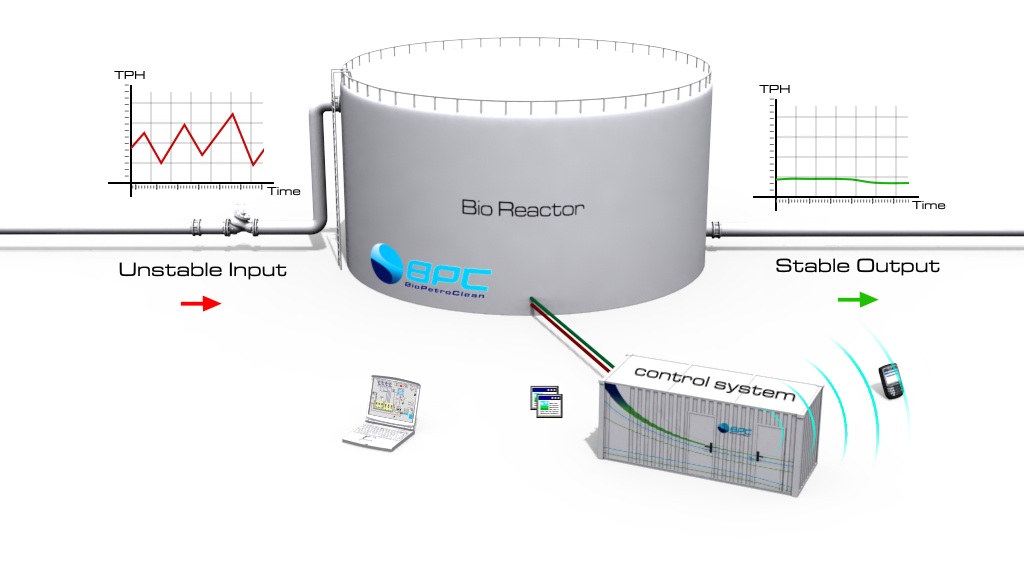
Figure 3: A schematic description of BPC ACT technology – “The bioreactor receives a highly contaminated (and sometimes fluctuating) inlet, and releases a low and stable outlet. The control unit continuously monitors the process.”
BPC’s cutting-edge biological method for wastewater treatment offers an elegant and simple solution to overcome the existing challenges of conventional biological methods. The Automated Chemostat Treatment™ (ACT) method is based on maintaining a pre-selected bacterial “cocktail” tailored for the specific wastewater type, at a stable and low concentration all while monitoring the system with a fully automated control unit. The control unit measures various parameters of the influent, including COD, Total nitrogen, Total phosphate, salinity, turbidity and pH, among others. The control unit is capable of automated nutrient dosing, and thus able to adjust the conditions in the bioreactor in order to maintain a stable output and prevent system upsets.
BPC’s Solution to the client’s need
The IOR effluent treatment plant contains, in sequence, a pH adjustment tank, an anaerobic hybrid reactor (AHR), a dissolved air flotation unit (DAF), two side by side aerobic bioreactor tanks and clarifiers (A and B), and finally a dual filtration system (figure 2). The BPC solution in this project involved two main stages. First, a feasibility study and extensive analyses of wastewater samples from the client’s site were performed at BPC’s laboratory, then engineering work was undertaken to design a retrofit process that would convert one of the two aerobic tanks, tank A, from AS to BPC-ACT. Finally, based on the design work, BPC obtained all necessary materials and quickly integrated the BPC-ACT solution to the IOR aerobic bio treatment system. This retrofit included installation of BPC’s custom control unit, as well as the addition of improved aeration throughout the bioreactor tank.
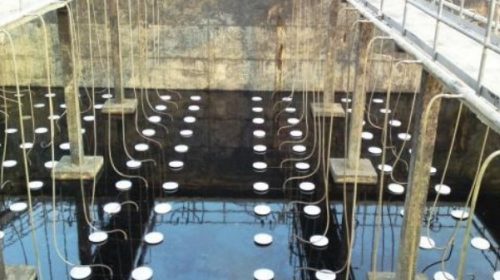
Figure 4: Improved aeration units being installed throughout the BPC ACT aerobic reactor.
Retrofit Configuration and Implementation
After completing the lab analysis and engineering design necessary to demonstrate the viability of ACT as an effective bioremediation solution, BPC proceeded with the on site system upgrade.
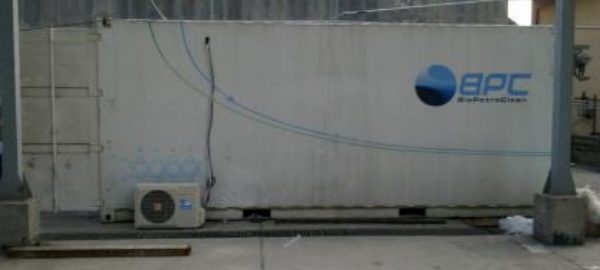
Figure 5: BPC-ACT skid mounted control unit installed on site at IOR
BPC’s work included first improving the aeration system in the tank A reactor by replacing the air diffusers throughout the tank and adding a mixing device (figure 4). Next the BPC skid mounted control system was added (figure 5) to the system to allow for constant monitoring of all important water qualities, both locally as well as online. Finally an automated nutrient dosing system was added to the bioreactor to allow the control unit to maintain stable conditions within the tank. The control unit preserves a steady state in the tank in spite of conditions in the incoming flow and with little human input required. The physical retrofit integration work was completed in just 20 days. The BPC-ACT and AS systems were operated in tandem for an initial period of 45 days, during which results were analyzed by BPC and in the IOR on site lab.
Retrofit Results
During the initial operating period, the water was sampled and analyzed by both BPC staff and the IOR’s on site laboratory, with similar results produced by both testing teams. Throughout the 45 day period the quality of incoming flow fluctuated greatly, with pH levels (as measured in the pH adjustment tank) ranging from 5 to 10 and COD inlet to the aerobic treatment ranging from 600 to 2,500 mg/lit. The BPC-ACT system performed well, treating IOR’s wastewater adequately for discharge to the environment.
Upon adding an RO filtration unit to the IOR system to remove salt content, effluent will fit specifications for use in the cooling and boiler feed. The system maintained a constant quality of effluent throughout the period, with COD outlet ranging from 100-150 mg/lit for a reduction of 85-90% from that of the incoming flow. The treatment results are presented in table 1 and figure 6 as follows.
| Units | BPC | AS | |
|---|---|---|---|
| COD inlet | mg/lit | 600-2500 | 600-2500 |
| COD outlet | mg/lit | 100-200 | 180-800 |
| COD reduction | % | 85-90 | 40-80 |
Table 1: Comparison of COD outlets achieved by BPC-ACT and AS
Automated Chemostat Treatment vs. Activated Sludge
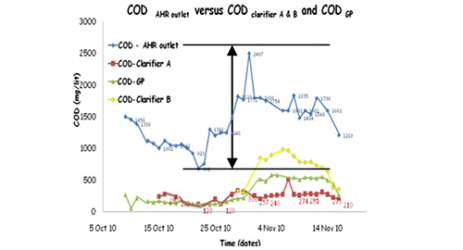
Figure 6: COD level in the influent (blue) vs. the BPC-ACT outlet (A – red), AS outlet (B – yellow) and both the BPC and AS outlets combined (green). Note that BPC outlet remained stable in spite of a drastic increase in inlet COD
During the 30 day period the BPC-ACT and AS aerobic tanks received identical water flows, with the only difference being the BPC control unit and the modified aeration and dosing systems. In the early days of the operating period both systems produced similar decreases in COD. However over a few days the incoming COD rose by 350% from 682 mg/lit to 2,497 mg/lit, and the BPC system from outperformed the AS in the face of this increase. Even during the period of increased COD, BPC-ACT continued to treat effluent to an output COD of 100-200 mg/lit. The AS system on the other hand was unable to cope with the changing conditions, resulting in an output COD as high as 800 mg/lit on the worst days. In total the AS outlet COD ranged from 180-800 mg/lit, for a reduction of 40-80%. These results are shown in table 1 and figure 6.
The Valuable Contribution of BPC
BPC’s solution for treating the produced water is highly advantageous for the following reasons:
- High efficiency- The BPC-ACT treatment of produced water can bring highly contaminated water to a purity level that allows for its reuse of benign discharge. The treatment process is completed with a relatively short retention time.
- Stable in the face of quality upsets (see figure 6 above) – unlike other technologies, BPC-ACT maintains exceptional operation regardless of fluctuating conditions in incoming water quality.
- Cost savings- BPC-ACT requires far less manpower for operation and maintenance, as well as fewer upsets in treatment quality.
- Simple implementation into current infrastructure- the retrofit process is based almost entirely on currently available infrastructure, thus considerably reducing the time and costs required for the system’s installation.
- Simple operation- the system is completely automated, leading to a simple and straightforward operation and eliminating the need for highly skilled operators.
The Next Step- Permanent System
Following completion of this successful retrofit, the IOR management was very pleased with the system’s performance. The combination of the BPC-ACT bioreactor’s easy operation and high reliability, despite unstable input conditions, yielded highly purified water that could later be recycled. Given how the BPC-ACT solution outperformed the AS system and the ease with which the retrofit itself was carried out, the logical next step is to convert Tank B to a BPCACT reactor as well. Furthermore the upgrade to Tank B can be carried out with a minimal disruption to IOR’s effluent treatment capabilities. The capacity of Tank A can temporarily be increased, so that even during retrofit process the IOR’s effluent treatment capacity will only diminish slightly. Following the upgrade to tank B, the aerobic component of IOR’s effluent treatment system will be carried out entirely by an Automated Chemostat System.
Summary
BPC offers a simple and efficient solution for upgrading old effluent treatment systems to a level that will allow for safe recycling or release of water, as well as lower overall costs and less maintenance. The BPC-ACT solution can easily be integrated into currently existing infrastructure, resulting in a more cost effective and environmentally friendly wastewater treatment. The retrofit process is quick and relatively painless, and leads to a superior a more stable means of effluent treatment.
Optimization Statistics
From the designers and engineers who are creating the next generation of web and mobile experiences, to anyone putting a website together for the first time. We provide elegant solutions that set new standards for online publishing.
Digital technology has made our world more transparent and interconnected, posing new challenges and opportunities for every business. A holistic, user-centric perspective is what truly sets one apart. together for the first time. We provide elegant solutions.
From the designers and engineers who are creating the next generation of web and mobile experiences, to anyone putting a website together for the first time. We provide elegant solutions that set new standards for online publishing.
We Will Be Useful to You
From the designers and engineers who are creating the next generation of web and mobile experiences, to anyone putting a website together for the first time.
Digital technology has made our world more transparent and interconnected, posing new challenges and opportunities for every business. As your budget progresses and evolves, continue referring to your SMART objectives. Stay focused and remember your goals – they will always inform what your next step will be!
From the designers and engineers who are creating the next generation of web and mobile experiences, to anyone putting a website together for the first time. We provide elegant solutions that set new standards for online publishing.
As your budget progresses and evolves, continue referring to your SMART objectives. Stay focused and remember your goals – they will always inform what your next step will be!


